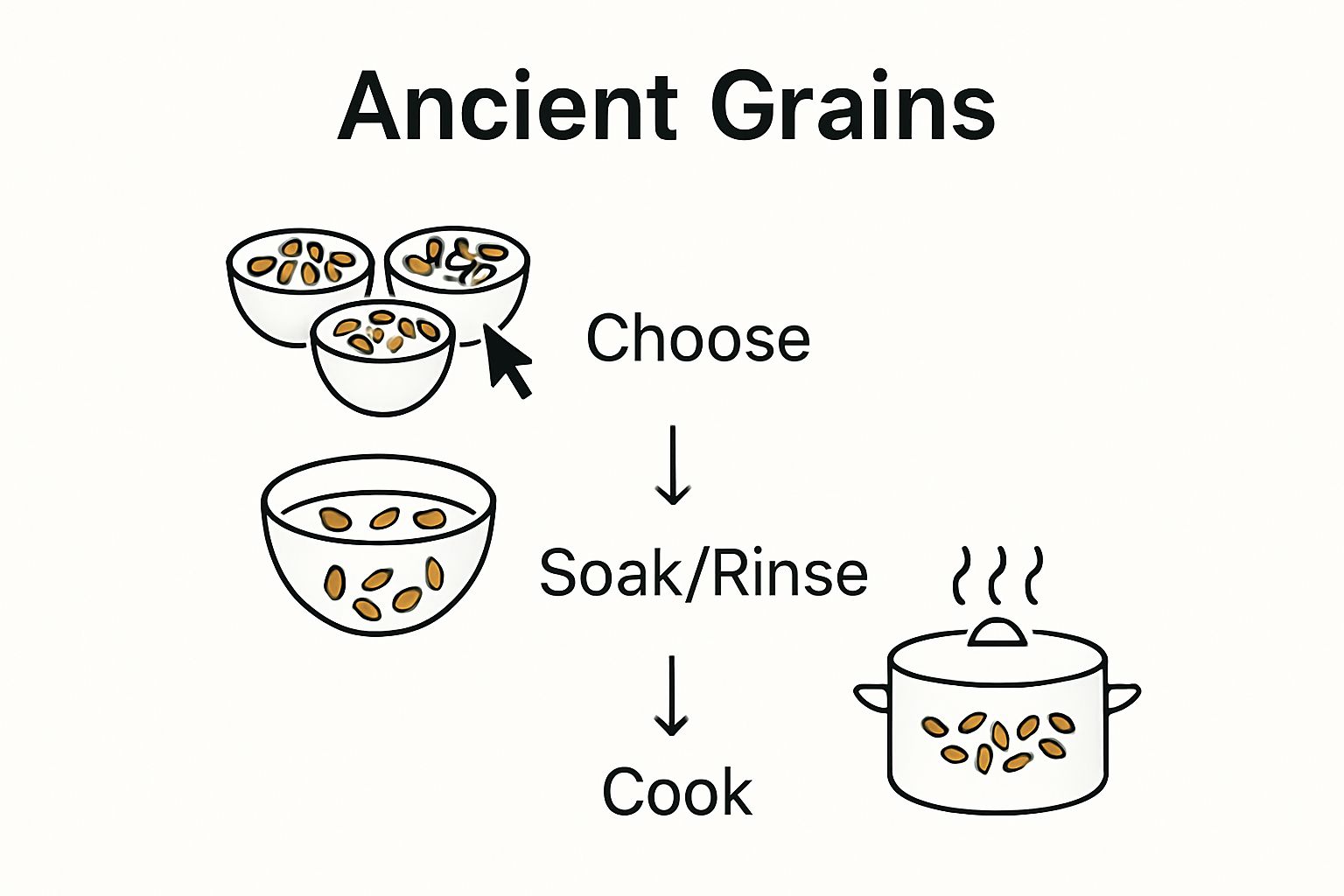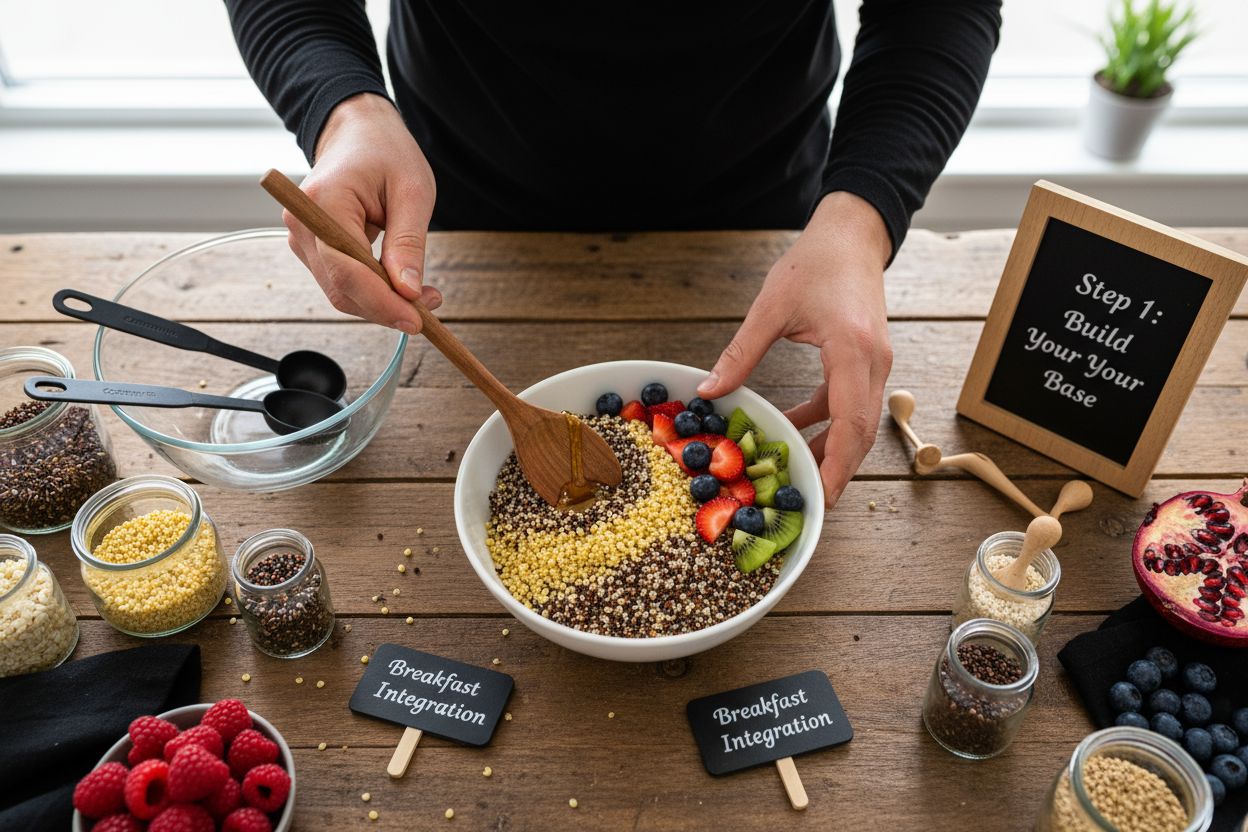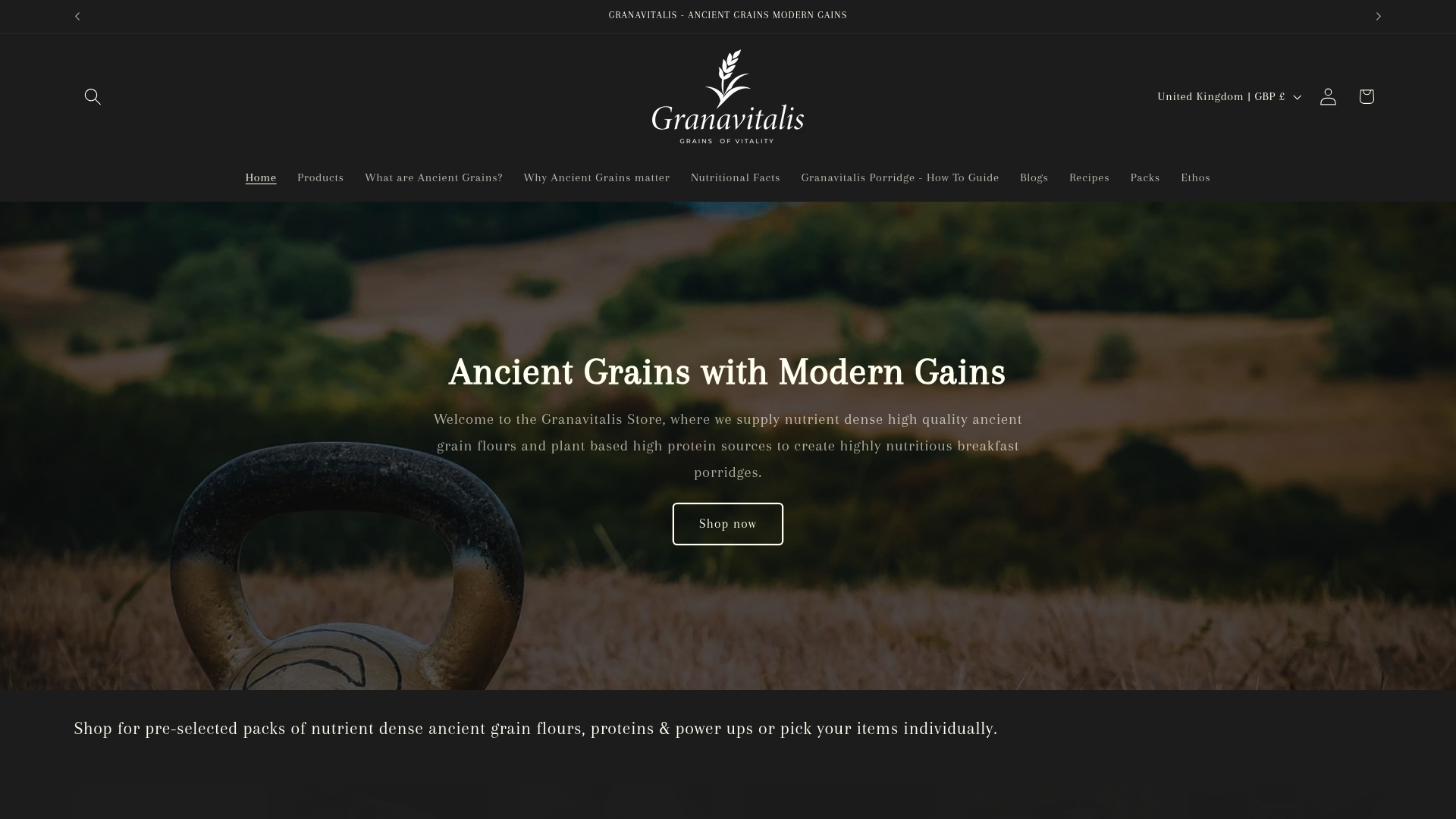
How to Incorporate Ancient Grains for Healthier Meals
Share
Ancient grains have quietly made their way back onto our shelves, promising an alternative to bland, processed staples. Most people do not realise that these grains, like quinoa and spelt, come with some astonishing nutritional power. Quinoa even contains all nine essential amino acids, a rarity in plant foods. People often assume making the switch is complicated or costly, but the real surprise lies in how simple and affordable it is to add these nutrient-rich staples to everyday meals.
Table of Contents
- Step 1: Identify Suitable Ancient Grains For Your Diet
- Step 2: Prepare Ancient Grains For Cooking And Consumption
- Step 3: Integrate Ancient Grains Into Breakfast Options
- Step 4: Experiment With Ancient Grains In Lunch And Dinner Recipes
- Step 5: Verify The Nutritional Benefits Of Your Meals
Quick Summary
| Key Point | Explanation |
|---|---|
| 1. Choose ancient grains based on needs | Select grains like quinoa or buckwheat based on health goals, dietary restrictions, and personal taste preferences to enhance nutrition. |
| 2. Prepare grains through soaking and rinsing | Soaking removes inhibitors like phytic acid, while rinsing eliminates bitter coatings, enhancing nutrient absorption and digestibility. |
| 3. Experiment with breakfast grain alternatives | Replace traditional grains with ancient grains like quinoa or amaranth to boost protein and overall nutritional value in morning meals. |
| 4. Integrate grains into lunch and dinner | Use ancient grains as substitutes for rice and pasta to diversify meals and increase nutrient density, ensuring balanced dishes. |
| 5. Monitor health effects of ancient grains | Maintain a food journal to track energy, digestion, and overall well-being, adjusting grain intake based on personal responses. |
Step 1: Identify suitable ancient grains for your diet
Understanding which ancient grains suit your dietary needs marks the crucial first step in transforming your nutrition. These nutrient-dense foods offer remarkable health benefits beyond typical modern wheat products, providing a foundational approach to more wholesome eating.
Starting your ancient grain journey requires thoughtful selection based on nutritional profile, taste preferences, and potential dietary restrictions. Learn more about understanding ancient grains to make informed choices that align with your wellness goals.
Grain Categories to Consider
Some ancient grains offer distinct nutritional advantages depending on your specific health objectives. Quinoa provides complete protein with all essential amino acids, making it ideal for vegetarians and those seeking muscle support. Spelt delivers complex carbohydrates with a nutty flavour, excellent for sustained energy release. Buckwheat, despite its name, is actually a seed and remains gluten-free, perfect for individuals managing wheat sensitivities.
Consider your personal health requirements when selecting. Those managing blood sugar might prioritise low-glycemic options like amaranth or teff. Athletes could focus on protein-rich grains like kamut or farro. Individuals with specific digestive concerns should introduce these grains gradually, monitoring how your body responds.
A strategic approach involves experimenting with small quantities initially. Purchase modest amounts from reputable sources, preferably organic and minimally processed. Check for potential allergen information and consult healthcare professionals if you have pre-existing dietary sensitivities.
By methodically exploring different ancient grains, you create a personalised nutritional toolkit that supports your individual wellness journey. Each grain brings unique micronutrients, textures, and culinary possibilities, transforming mundane meals into nutritional powerhouses.
Quick Verification Checklist:
- Select 2-3 different ancient grains to start
- Verify source quality and organic certification
- Confirm compatibility with personal dietary needs
- Plan initial recipe experimentations
Step 2: Prepare ancient grains for cooking and consumption
Preparing ancient grains requires thoughtful techniques that unlock their nutritional potential and enhance digestibility. Discover why ancient grains matter and learn how proper preparation transforms these remarkable ingredients into delicious, nutrient-rich meals.
Soaking and Rinsing Techniques
Before cooking, most ancient grains benefit from a systematic preparation process that removes natural protective compounds and improves nutrient absorption. Soaking grains like quinoa, amaranth, and buckwheat for 6-8 hours helps neutralise phytic acid, a substance that can inhibit mineral absorption. Use cool water and cover the grains completely, allowing them to rest in a cool area of your kitchen.
Rinsing becomes crucial, especially for quinoa, which contains saponins that create a bitter coating. Run cool water through the grains using a fine mesh strainer, gently rubbing them together to remove any residual coating. This simple step dramatically improves flavour and reduces potential digestive discomfort.
Cooking Methods and Timing
Each ancient grain demands slightly different cooking approaches. Quinoa typically requires a 2:1 water to grain ratio and cooks in approximately 15 minutes. Amaranth needs more water and longer cooking times, usually around 25 minutes. Experiment with liquid ratios and cooking times to achieve your preferred texture.
Consider toasting grains before cooking to enhance their nutty flavours. Heat a dry pan and gently toast grains for 2-3 minutes, stirring constantly to prevent burning. This technique works wonderfully with millet, sorghum, and teff, releasing complex aromatic compounds that elevate your culinary experience.
Verification Checklist:
- Grains are thoroughly rinsed
- Soaking time completed (6-8 hours recommended)
- Water is fully absorbed during cooking
- Grains have a fluffy, separate texture
- No bitter or unusual aftertaste present
By mastering these preparation techniques, you transform ancient grains from raw ingredients into nutritional powerhouses ready to support your wellness journey.

Step 3: Integrate ancient grains into breakfast options
Transforming your morning meal with ancient grains opens a world of nutritional possibilities beyond traditional breakfast fare. Explore our guide to ancient grains for breakfast and discover how these nutrient-dense ingredients can revolutionise your first meal of the day.
Porridge and Breakfast Bowl Strategies
Quinoa and amaranth emerge as stellar alternatives to standard oatmeal, offering remarkable protein content and complex nutritional profiles. Begin by replacing half your usual porridge volume with these ancient grains, gradually increasing the proportion as your palate adjusts. Cook quinoa with a touch of cinnamon and almond milk for a creamy, warming breakfast that provides sustained energy throughout the morning.
For those seeking variety, create versatile breakfast bowls that combine multiple ancient grains. Mix cooked millet with chia seeds, top with fresh berries, and drizzle with honey for a balanced meal that delivers essential micronutrients. Teff works particularly well in morning recipes, offering a rich, slightly nutty flavour that complements fruits and nuts perfectly.
Experimentation becomes key in developing delightful morning routines. Consider preparing grain mixtures in advance, storing them in refrigerated containers for quick morning assembly. Batch cooking allows busy individuals to maintain nutritious breakfast habits without significant time investment. Pro tip: Toast grains lightly before cooking to enhance their natural flavours and create more complex taste profiles.
Adapt your approach based on personal preferences and dietary requirements. Individuals managing blood sugar levels might prioritise lower-glycemic grains like buckwheat, while athletes could focus on protein-rich options like amaranth. The goal remains creating breakfast solutions that nourish both body and mind.
Breakfast Integration Checklist:
- Experiment with 2-3 different ancient grain combinations
- Prepare base mixtures in advance
- Include diverse toppings for nutritional variety
- Monitor energy levels and satiety after consumption
- Adjust grain ratios according to personal taste and nutritional needs
By thoughtfully incorporating ancient grains into your breakfast routine, you transform a simple meal into a powerful nutritional strategy that supports holistic wellness.

Step 4: Experiment with ancient grains in lunch and dinner recipes
Transitioning ancient grains from breakfast to lunch and dinner transforms your entire nutritional approach. Learn about the benefits of replacing modern grains and discover how these nutrient-dense ingredients can revolutionise your main meals.
Versatile Grain Replacement Techniques
Consider ancient grains as direct replacements for traditional rice, pasta, and wheat-based products. Quinoa serves as an exceptional base for grain bowls, absorbing flavours from roasted vegetables and lean proteins. Farro provides a delightful chewy texture in salads, while amaranth can replace breadcrumbs in vegetarian patties, adding substantial protein and creating a satisfying meal structure.
Salads represent an ideal starting point for grain experimentation. Combine cooked millet or sorghum with roasted seasonal vegetables, creating nutrient-dense meals that offer complex carbohydrates and essential minerals. Teff works wonderfully in warm grain salads, its tiny seeds providing a delicate texture that complements robust ingredients like roasted butternut squash or grilled Mediterranean vegetables.
Strategic Cooking and Flavour Development
Mastering ancient grain cooking requires understanding their unique characteristics. Some grains, like kamut, benefit from longer cooking times and more liquid, while others, such as buckwheat, cook quickly and absorb flavours intensely. Develop a systematic approach by preparing small batches and documenting your preferred cooking methods.
Integrate these grains into familiar recipes to ease the transition. Replace standard risotto rice with barley for a more nutritious alternative, or use quinoa in stir-fries instead of traditional rice. The key is gradual introduction, allowing your palate to adapt and appreciate the nuanced flavours of these ancient ingredients.
Meal Experimentation Checklist:
- Try 3-4 different ancient grains in main course recipes
- Experiment with grain substitutions in familiar dishes
- Balance grain quantities with proteins and vegetables
- Note flavour profiles and personal preferences
- Adjust cooking techniques for optimal texture
By embracing ancient grains in lunch and dinner recipes, you create meals that are not just nutritionally superior but also incredibly satisfying and diverse.
Step 5: Verify the nutritional benefits of your meals
Tracking the nutritional impact of incorporating ancient grains requires systematic observation and personal health awareness. Explore plant-based protein strategies to complement your ancient grain journey and enhance overall nutritional understanding.
Personal Health Monitoring Techniques
Nutritional verification extends beyond simple calorie counting. Begin by maintaining a detailed food journal documenting your meals, ancient grain varieties consumed, and subsequent energy levels, digestive comfort, and general well-being. Pay special attention to subtle changes in metabolism, cognitive function, and physical performance.
Consider scheduling periodic health assessments with healthcare professionals who can provide comprehensive nutritional analysis. Blood tests measuring markers like cholesterol, blood sugar, and inflammatory indicators offer objective insights into how ancient grains impact your metabolic health. Pro tip: Request a comprehensive metabolic panel that includes micronutrient assessments to understand the deeper nutritional changes occurring in your body.
Physical indicators provide valuable feedback about your dietary transformation. Observe changes in muscle recovery, sustained energy levels, and overall stamina. Ancient grains like quinoa and amaranth deliver complete proteins and complex carbohydrates, which can significantly influence physical performance and recovery times.
Psychological and emotional well-being represent another crucial verification dimension. Many individuals report improved mental clarity, reduced afternoon energy crashes, and more stable mood patterns when transitioning to nutrient-dense ancient grain diets. Document these subjective experiences alongside more measurable health markers.
The following checklist table clarifies how to verify nutritional benefits when incorporating ancient grains into your meals, making it easier to track key aspects of your health transformation.
| Verification Aspect | What to Track | Frequency |
|---|---|---|
| Energy levels | Morning, afternoon, and evening energy changes | Daily |
| Digestive comfort | Bloating, regularity, and discomfort | Daily |
| Weight and body composition | Changes in weight or muscle/fat balance | Weekly |
| Cognitive performance | Focus, clarity, and mental energy | Daily |
| Professional health assessments | Blood tests and metabolic panels | Quarterly |
| Mood and emotional well-being | Stability of mood and emotional responses | Daily |
Nutritional Verification Checklist:
- Track energy levels throughout the day
- Monitor digestive comfort and regularity
- Record weight and body composition changes
- Note cognitive performance and mental clarity
- Schedule professional health assessments quarterly
By approaching nutritional verification as a holistic, multifaceted process, you transform dietary experimentation into a personalised wellness strategy that adapts and evolves with your unique physiological needs.
Make Ancient Grains the Heart of Every Meal
Are you struggling to replace refined grains and bring truly nourishing, satisfying foods back to your table? The article highlights how confusing it can be to identify, prepare, and actually enjoy ancient grains daily. These challenges often lead to subpar meals that fall short of supporting your long-term health and well-being. By focusing on nutrient-rich choices and balanced breakfast options, you can turn mealtimes into powerful building blocks for a healthier future. Discover the full spectrum of possibilities with our premium All Flours collection, featuring time-tested ingredients trusted for centuries.

Taste the difference real nourishment makes. Visit Granavitalis right now and experience unmatched quality, flavour, and variety. Whether you need traditional or Gluten Free Flours, we make it easy for you to elevate any meal with the natural power of ancient grains. Start transforming your health, one wholesome bowl at a time.
Frequently Asked Questions
What are ancient grains and what are their health benefits?
Ancient grains are traditional grains that have been cultivated for thousands of years. They include quinoa, spelt, amaranth, and buckwheat. These grains are nutrient-dense, offering high levels of protein, fibre, vitamins, and minerals, making them a healthier alternative to modern grains like refined wheat.
How should I prepare ancient grains before cooking?
Most ancient grains benefit from soaking and rinsing before cooking. Soaking for 6-8 hours can help neutralise phytic acid, improving nutrient absorption. Rinsing grains like quinoa is crucial to remove saponins that can impart a bitter taste. Follow specific cooking guidelines for each grain to achieve the best texture and flavour.
Can I substitute ancient grains for modern grains in recipes?
Yes, ancient grains can often be used as substitutes for modern grains in various recipes. For instance, quinoa can replace rice in grain bowls, while farro can add texture to salads. Start by experimenting with familiar dishes to ease the transition and adjust cooking methods accordingly.
How do I track the nutritional impact of ancient grains on my diet?
To monitor the nutritional impact, maintain a food journal documenting your meals, including the types of ancient grains consumed. Pay attention to changes in energy levels, digestion, and overall well-being. Regular health assessments can also provide insights into how these grains affect your metabolic health.
